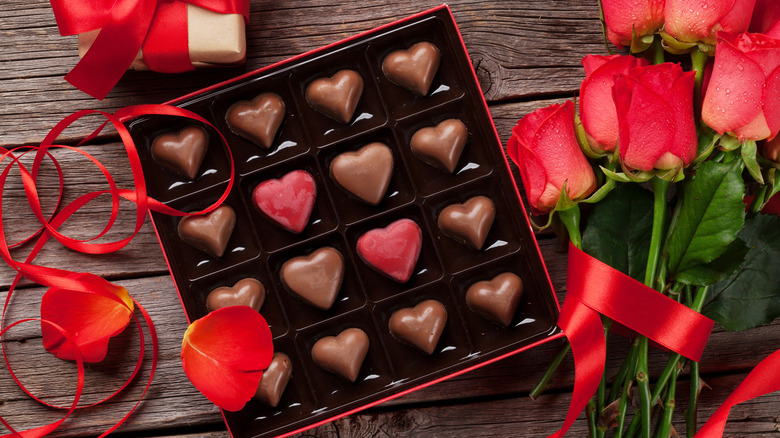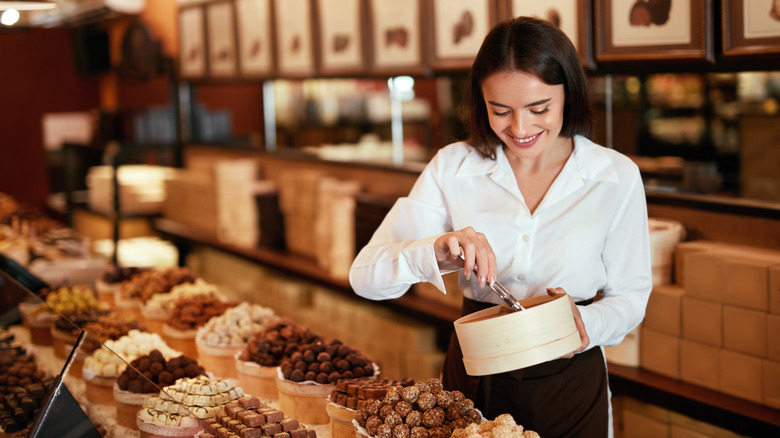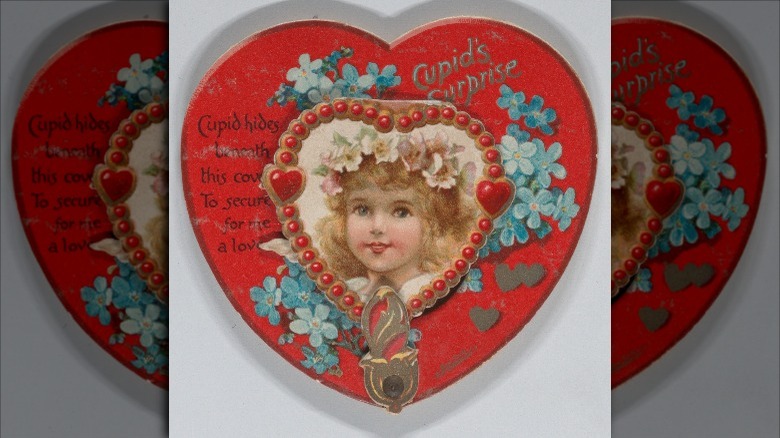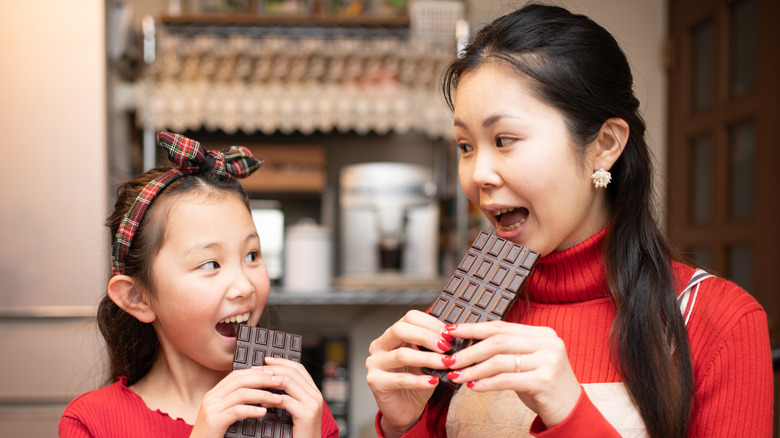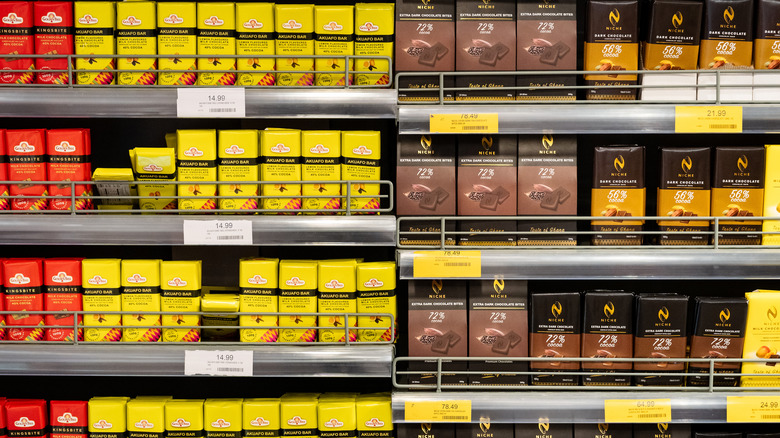The Surprising Origin Story Of Chocolate On Valentine's Day
While some may think Valentine's Day is for lovers, the real truth of the matter is that it's a holiday that's just perfect for chocolate lovers. Whether or not you're in a relationship, you can always be blissfully in love with this glorious confection.
How did chocolate come to be associated with what started out as the feast day for a once-obscure Roman saint? Saint's days, on their own, are no rarity — according to the Roman Catholic church, the liturgical calendar shows that February 14 is a day dedicated to the memory of no fewer than five saints: Sts. Cyril, Monk, and Methodius, bishop patrons of Europe, St. Zenon, martyr on the Appia, and St. Valentin, martyr on the Via Flaminia. Every other day also has its full complement of holy men and women, yet we don't break out the candy boxes 365 times a year.
In order to sort out the link between Valentine's Day and chocolate, Mashed went straight to a chocolate expert: Michael Laiskonis, the chef who created the Chocolate Lab at the Institute of Culinary Education. Laiskonis took our query quite seriously and did some serious sleuthing to come up with his answer.
Chocolate candies themselves are a fairly recent creation
Before chocolate candies could become a popular love gift, they had to come into being, and chocolate candy is fairly recent as far as foodstuffs go. Chocolate itself is a new world discovery, so Western Europe didn't really become familiar with it until post-Columbian days. While the first chocolate bars date back to the mid-19th century, Laiskonis notes that up through the turn of the century, chocolate for the most part was primarily considered to be a beverage with a secondary use as a flavoring, much as coffee and tea are to this day. (Could coffee candy bars be a thing in the future? Laiskonis didn't speak to this, but it's an intriguing prospect.)
"The earliest chocolate 'bonbons'," Laiskonis told Mashed, "were typically very sweet sugary centers flavored with fruits, flowers, and spirits [and] dipped in chocolate coatings." Ganache-style or cream centers, something he calls "chocolate candy at its most luxurious," may date back to the 19th century, but really took off once 20th-century refrigeration techniques improved. The birth of such candies just so happened to coincide with a boom in media and advertising that Laiskonis theorizes "helped sell the fetishization of chocolate in general, which arguably also plays a role in the modern bond between chocolate and romance."
Early Valentine's Days didn't include chocolates
While the earliest Valentine card known to history dates back to the 15th century, it was penned by a nobleman. It seems doubtful that it was common practice for the average Joe Serf to take time off from his daily serfing duties every February 14 to write love poems to Mrs. Serf. Even if he did, his unlikely efforts would likely be greeted with, "Get your stinky self out of here! We've already got 15 kids and the weather report is calling for plagues and pestilence again." By the mid-19th century, Valentines of the paper kind seemed to be popular amongst those who were able to afford the fancy creations being sold at stationers and department stores, but even then, it was just paper that was changing hands.
Legend has it that Cadbury was the first chocolate manufacturer to present its product in a heart-shaped box back in the 1860s. Laiskonis says, though, that in the U.S. one of the earliest mentions of candy in conjunction with Valentine's Day appears in what he calls a "brief and cynical blurb" from the 1873 Brooklyn Union: "The vulgar valentine is flaunting its polychromatic hideousness in dirty little candy stores." By the 1890s, he told us, ads for Valentine's candy complete with heart-shaped boxes were becoming more commonplace, and before World War I, Valentine's chocolate was firmly entrenched in our culture.
Valentine's chocolates might have something to do with its supposed aphrodisiac qualities
Besides the association of chocolate with luxury, thus making it a desirable gift on this account alone, Laiskonis says that the whole Valentine's Day connection to chocolate may have something to do with its supposed aphrodisiac properties. While he doubts that there has been any solid evidence to support this idea, he does say that "the lore is deeply embedded in courtship" and reveals that some historians suggest that the idea of chocolate as a love potion may date back to pre-conquest Mesoamerica.
But what about all of the claims of chocolate as a mood booster? Laiskonis is a bit skeptical of these as well, telling us that the scientific studies he's seen tend to indicate that chocolate's effect on our brains is pretty ephemeral. Still, there's no doubt that the act of eating chocolate does bring joy and pleasure to most of us, so giving somebody a big box of chocolate is tantamount to saying "I want you to be happy." Even if the person you're gifting with chocolate is yourself, there's no higher expression of love.
Japan has different categories of Valentine's chocolate
While Valentine's chocolate may have European origins, it's been embraced by the Japanese in recent years. It seems they've gotten candy-giving down to a science as there are specific names for different categories of chocolate gifts. Honmei choco (love chocolate) is given by women to their boyfriends, while gyaku (reverse) choco is something men give their girlfriends. (The former is more common, since March 14, aka White Day, is the day men traditionally recognize their significant others with gifts.) Once a romance becomes a marriage, the wife gives her husband fami (family) choco instead, and this may be gifted to parents and children as well.
Giri (obligation) choco is something you might give to a boss or a teacher, while tomo (friendship) chocolate you give to your friends. Best of all, there's even a tradition of giving jiko choco to yourself. No shame at all in being single on Valentine's Day in Japan, or in celebrating that singleness with chocolate you don't have to share.
In Ghana, Valentine's Day is all about love ... of chocolate
The U.S., along with several European countries, may rank among the world's top chocolate producers, but Ghana and the Ivory Coast supply 60% of the cacao beans used in its making. Approximately 90% of Ghana's agriculture industry is cacao-based, so in 2005 the country declared February 14 to be National Chocolate Day to celebrate its famous export. Chocolate Day proved to be such a success — as why should it not? — that in 2022 it was stretched out to National Chocolate Week.
While Ghanaians may observe the occasion by gifting chocolate as the Ghana Tourism Authority encourages them to do, the holiday is more of an opportunity to showcase and celebrate Ghana's place in world chocolate production. One way this is done is to give a little love to the country's home-grown chocolatiers — despite the fact that much of Ghana's cacao crop is exported for processing elsewhere, Ghana still boasts a number of domestic chocolate companies. Among the better-known ones are Golden Tree, which operates under the aegis of the country's Cocoa Processing Company; Fairafric, the first company in Ghana to produce organic chocolate; and 57 Chocolate, a brand named after the year Ghana established its independence (that being 1957). While the first two don't seem to ship their products to the U.S., 57 Chocolate is available in select stores in Austin, Texas; Dayton, Ohio; San Francisco; St. Louis; and Washington, DC.
